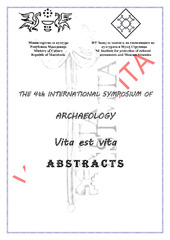Приказ основних података о документу
Life in white: symbolism and importance of the white colour in the Neolithic in the Balkans
| dc.creator | Antonović, Dragana | |
| dc.creator | Vitezović, Selena | |
| dc.creator | Dimić, Vidan | |
| dc.date.accessioned | 2023-11-23T10:24:42Z | |
| dc.date.available | 2023-11-23T10:24:42Z | |
| dc.date.issued | 2016 | |
| dc.identifier.uri | http://rai.ai.ac.rs/handle/123456789/812 | |
| dc.description.abstract | Colour always played an important role in everyday and ritual life of past communities. Identifying the meaning and value of diverse colours is sometimes difficult, but still not impossible task. It is well known that green colour has the special significance in the Early Neolithic in the East and Central Balkans ("nephrite culture" of the East Balkans, wide use of greenish stones for tools in theCentral Balkans). In the Neolithic and Early Eneolithic in the Central Balkans, the white colour seems to have been of particular importance. White stones were commonly used for production of cult and decorative objects like amulets, pendants, beads and rings. All these objects were made from marble and marble onyx, sometimes imitating shells like Spondylus. Furthermore, rare vessels made from stone were all made from white stones, such as marble. It is particularly interesting to note the wide use of the so-called light white stones in the Vinča culture like magnesite, tuff, white chert etc. Although those rocks are not of high quality comparing with crystalline schists and metamorphosed sandstones used for production of tools during Starčevo and Early Vinča cultures, they became very popular in late phases of Vinča culture, in the same time when metallurgy was born in central Balkans. Osseous raw materials, naturally white or whitish, were used for daily tools but were also preferred raw material for decorative items in both Starčevo and Vinča cultures. In particular were preferred mollusc shells, which are shiny, bright white and they were even sometimes replaced by replicas in white stones. The aim of this paper is to present the importance of the white colour and to give possible answers to the question on the significance and meaning of the white colour to inhabitants of the Central Balkans in the Neolithic and Early Eneolithic, periods when metal was invented. | sr |
| dc.language.iso | en | sr |
| dc.publisher | Strumica : NI Institute for protection of cultural monuments and Museum Strumica | sr |
| dc.relation | info:eu-repo/grantAgreement/MESTD/Basic Research (BR or ON)/177020/RS// | sr |
| dc.rights | openAccess | sr |
| dc.source | The 4th International Symposium of Archaeology, Vita est vita, 3-6. November 2016, Strumica | sr |
| dc.subject | Neolithic | sr |
| dc.subject | Balkan | sr |
| dc.subject | White colour | sr |
| dc.subject | symbolism | sr |
| dc.subject | Stone tools | sr |
| dc.subject | Bone tools | sr |
| dc.title | Life in white: symbolism and importance of the white colour in the Neolithic in the Balkans | sr |
| dc.type | conferenceObject | sr |
| dc.rights.license | ARR | sr |
| dc.citation.epage | 2 | |
| dc.citation.spage | 2 | |
| dc.description.other | In: Sekulov, V. (ed.), Book of abstracts of 4th International Symposium of Archaeology, Vita est vita, 3-6. November 2016, Strumica, Macedonia (pp. 2). | sr |
| dc.identifier.fulltext | http://rai.ai.ac.rs/bitstream/id/1848/bitstream_1848.pdf | |
| dc.identifier.rcub | https://hdl.handle.net/21.15107/rcub_rai_812 | |
| dc.type.version | publishedVersion | sr |


